History of the 1968-1971 Dodge Super Bee
Joe Moore
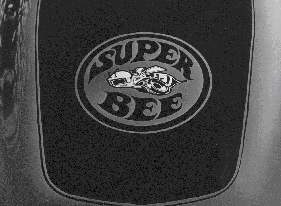
Two cars paved the way for a decade of high performance, Ford Mustang and the Pontiac GTO. Both began a revolution of the young. Suddenly the youth market was the bulls-eye to aim for. Chrysler's set back and wait motif policy gave them an edge. They saw that there were two kinds of super car buyers. Those that wanted the power but did not want to give up luxuries of a rich interior and the comforts that go with it. Then there was the Saturday Cruise Night buyer. This market wanted a full-out power driven drag racer for the street and most of all it had to be economical-under $3000.00.
This decal left no doubt. It was all muscle-car.
It was the best of both youth markets affordable like the Mustang, and power hungry like the GTO, and no one offered it. Plymouth began the battle plans for the untapped market by drawing up an add and delete sheet for the middle sized Belvedere line. To keep the car affordable it had to have a low production cost, it had to use what parts were available. Also a common way to keep production costs down was to share a design with their sister company- Dodge, which is what they did. Plymouth got the Road Runner, and Dodge got the Super Bee.
Dodge followed Plymouth's lead they use the same practice of add and delete to a Coronet 440 2-door coupe, which is the cheapest to produce and why that body style was chosen. A special hood was a requirement for a muscle car, but tooling up another hood would have added to the cost, it was decided it would share the Coronet R/T's hood. A blacked out grille was also part of the package, so once again it shared R/T's components. However, the yet unnamed model need a tie to the Coronet line, thus it would use the DODGE spelled out across the grille in bold letters.
Of course the Hemi was discussed as the possible standard motivation, but was quickly dismissed because it would have added greatly to the base list price, instead it would become the only optional powerplant listed. Marketing refused the use of the 440 Magnum , fearing it would cut into the Coronet R/T's sales. In fact, this is the reason that the 440 Magnum was not allowed to even be an option in the Super Bee line up.
The Big, the Bad and the Fast!
No other engine can compare. The 426 Hemi is the King of the street and Strip. It ranked up more wins then any other powerplant. It reamined optional (the only option in 1968 and 1969) through the Super Bee's short four years of existance.
|
PRODUCTION TOTALS
1968
Coupe- 125
1969
Coupe- 166
Hardtop- 92
1970
Coupe- 4
Hardtop- 32
1971
Hardtop- 22
|
Total Super Bee Hemi
Production: 441
|
The next choice was the 383-ci big block, but this same powerplant was powering mundane Coronet's this car need something special. It could have the same rating as Dad's four-door. Fortunately for Dodge ,Plymouth had all ready taken care of this problem by blending the best parts of the 440 Magnum and placing them on the 383-ci four-barrel V-8. By using the 440 heads and camshaft , the carburetor proved to be too much for the engine and a new AVS four barrel was drawn up, horsepower rating was upped to 335 hp. These improvements were was just a five horse increase over the standard 383-ci four-barrel, but it was enough. They dubbed the new creation, naturally the 383- Magnum.
Inside is where cost savings were realized. It came standard with a full width split back bench seat done in Taxi grade interior trim. Bucket seats were not even listed as an option. Color choices were Blue, Black, Red, Green or White. If this was a muscle car it had to have musclecar instrumentation. Charger's Round faced cluster was a natural, it would be the cluster that would give the Super Bee an edge over it's sister the Road Runner in it reputation in the muscle car wars.
The Super Bee name came about because of the rear end stripes. The twin stripe pattern was placed on the tail of the car, an unusual thing back then . Calling these, bumble bee stripes Dodge created an entire marketing campaign featuring their high performance cars, calling them the "Scat Pack". Needing a logo or mascot to draw the package together, a Bumble bee wearing a crash helmet and sporting huge wide slicks was created- the Scat Pack bumble bee. When shown to Burt Bouwkamp-then Product Planning Manager- he remarked it looked like a Super Bee. What a great name! Thus the name was born. This bee would find itself being stuck to the rear deck lid and on the rear quarter panels of Dodge's new super coupe.
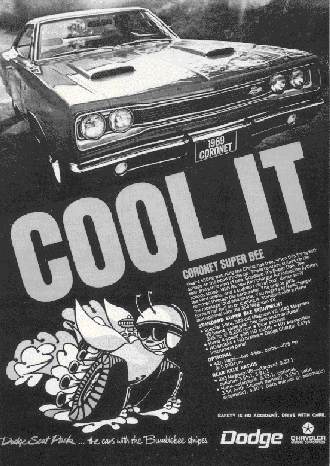
There was only refinement for 1969, a Super Bee emblem adorned a new grille and rectangular shaped running lamps marked the body sides. A hardtop coupe join the Super Bee's ranks, but a convertible was not part of the plan, as the base Coronet 440 did not offer this body style. The standard hood was the same as the one used in 1968, but a new fresh air hood package called "Ram Charger", named after the famous drag racers in the early 1960's, was released. This package added twin scoops that rammed cold air down into the carburetor. It was one of the hottest looking packages at that time, and it was definitely not for those who did not want to draw attention to themselves.
A Super Bee medallion was also placed on the rear deck lid on the right-hand side. The tail end was high lighted with a flat black trim panel, that supported the Dodge name, placed in between the tail lamps. One the side the twin stripes were grafted into one single wide stripe, with thin border stripes and the Super Bee logo. If the stripes were deleted then, the logo itself was used.
Inside the Coronet 440 trim was again used, and a bench seat was standard and available in Light blue, White, Green, Red or Tan. Bucket seats found their way into the option book, and were available in Dark Blue, White, Green, Red, Tan or Black.
The Charger instrumentation was still standard.
This ad announced the RamCharger option. Chrysler Photo
Order Jake Hare's new guide "MOPAR BROADCAST SHEET DECODER MANUAL 1969-1974". This 130 page guide enables you to decode your Mopar's Build Sheet from the first line to the last line. Covers all Mopar models from a six cylinder Duster to a Hemi Charger.
Only $19.97 plus $.4.95 S&H Order it now.
To Order Click on the banner
|
A rare midyear package option was the Dodge 440 Six. Finally the Super Bee was offered with the 440-ci powerplant. But this special powerhouse featured three two barrel carburetors, a special camshaft, and other components that built the horsepower up to 390 hp. To further draw attention, the car came with a flat black lift off fiberglass hood that featured a large molded in air scoop, with the Six Pack decals on the sides. Hub caps were deleted from the 15 inch steel wheels and chrome lug nuts dressed up the package and gave it that rough and tumbled look, while 4.20 Dana axle gears with a four-speed or automatic gave it the get up and go. Exterior colors were limited to Bright red, Bright green, Bright Yellow or Hemi Orange. 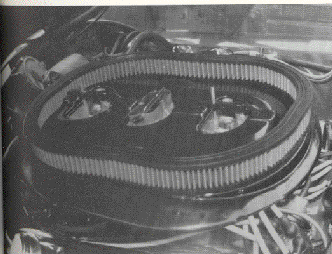 A black or white vinyl top was optional. The Bumble bee stripes were part of the package, but were available only in white or black. Red bumble bee stripes were used on production Bees, but not available on the Six Pack models.
A black or white vinyl top was optional. The Bumble bee stripes were part of the package, but were available only in white or black. Red bumble bee stripes were used on production Bees, but not available on the Six Pack models.
 A black or white vinyl top was optional. The Bumble bee stripes were part of the package, but were available only in white or black. Red bumble bee stripes were used on production Bees, but not available on the Six Pack models.
A black or white vinyl top was optional. The Bumble bee stripes were part of the package, but were available only in white or black. Red bumble bee stripes were used on production Bees, but not available on the Six Pack models.Three 2-bbl Holley carbuerators were part of the powerhouse recipe that made the 440 Six Pack cook, witha blazing 390 hp.
It reamined optional for 1970 and 1971 models. It was special package for 1969, and not considered an option.
PRODUCTION TOTALS
|
|
Year
|
Total
|
1969
|
Coupe- 618
Hardtop- 1,010
|
1970
|
Coupe- 196
Hardtop- 1,072
|
1971
|
Hardtop- 99
|
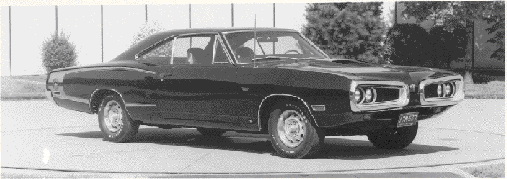
1970 Super Bee received a face lift for an aging design. Chrysler Photo
The aging Coronet's body style was given a face lift for 1970. The front fenders were sloped down more at the ends , and the hood featured a NASA inspired integrated hood scoop on the standard set up that flowed down into a center peak separating a twin front bumper arrangement. A Super Bee medallion was used between the grilles on the hood. The Ram-Charger hood with it's twin hood scoops were carried over to the new hood as an option.
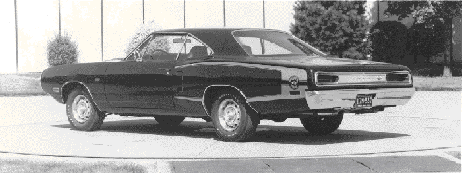
The rear quarter panel stripes had the same format as in 1969, but now included green and blue that were added to the color choices. However, an alternate stripe pattern called a reverse C stripe that used twin hockey stick stripes with the Super bee logo on the rear quarter panel holding it all together was also offered. For the first time the 440 Six Pack was offered as a full model option, Hemi also remained optional.
Optional Rear quarter stripes were offered in 1970. Chrysler Photo.
The cards of marketing were reshuffled for 1971. The Coronet name it felt was too closely tied with the image of grocery getters and mom and dad. Thus all four-door mid-sized Dodges would be known as Coronets, while all two-door intermediate Dodge models would be known as Chargers. The Charger would be restyle to meet these demands with long flowing lines that took some of the race car look away from it. The reshuffle of nameplates also brought the seeming death to the Coronet R/T and the Super Bee. However, it was only half right. The R/T was never a true contender on the marketing field, so it was killed while the Super Bee was given one more year to prove itself. Be the fates of soaring insurance rates and government regulations only place the Super Bee on life support, as this would be its last year of production.

1971 Super Bee was available on the newly restyled Charger-Chrysler Photo
The standard set up nearly the same as before, except that the 383-ci was now rated at 300-hp. Super Bee Decals were placed on the hood , the Super Bee nameplate and small bumble bee decal replaced the Charger's name on the front fenders. Inside the low ball Charger bench seat was standard, with the Charger round faced instrument cluster was also standard. The Super bee nameplate was used above the glove box for identification for the interior . Color choices were Blue, Green, Tan, Black, Gold or White. Bucket seats were optional in the same trim colors plus Gunmetal gray/black.
Power options were the same as they were in 1970 with the only options being the 426 Hemi and the 440 six package. The 440 Magnum was never officially listed as an option on the Super Bee. Late in the year a new option appeared it was the 275-hp 340-ci small block. This engine was the silent sobbing of a high performance car dying. It was the final nail driven into the Super Bee's coffin. While small blocks were the hot ticket for smaller models like Dusters and Challengers, it was a big let down from the Banshee wail of massive big block. Or to hear that suddenly intake of air from huge multiple carburetors as they suck in a deep breath of fresh air, before rocketing you down that two lane stripe of pavement. Memories are all that is left. But every once a while keep your ears open for that familiar buzz coming down the road and be warned it may be a KILLER BEE.
Production Totals
Body Style
|
1968
|
1969
|
1970
|
1971
|
2-dr Coupe
|
7,842
|
7,650
|
3,640
|
N/A
|
2-dr Hdtp.
|
N/A
|
18,475
|
10,614
|
4,144
|
.